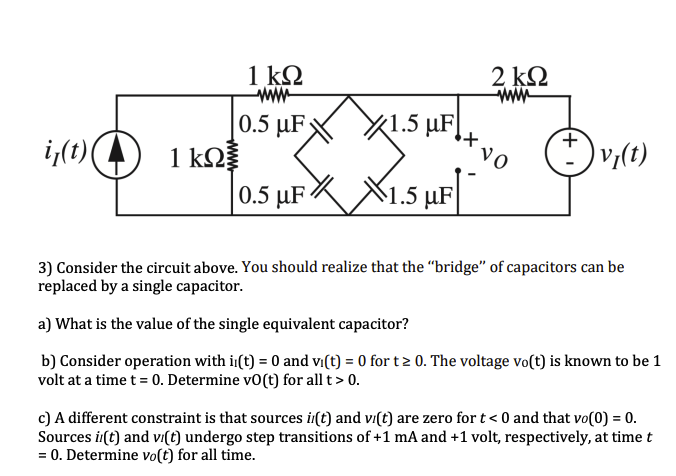1 kQ www 2 ΚΩ www µF 1.5 µF i(t) ( 1 kΩ (0.5 NEXXIS HEL+VO ⒸV (1) [0.5 μFX1.5 µF 3) Consider the circuit above. You should realize that the "bridge" of capacitors can be replaced by a single capacitor. a) What is the value of the single equivalent capacitor? b) Consider operation with i(t) = 0 and vi(t) = 0 for t≥ 0. The voltage vo(t) is known to be 1 volt at a time t = 0. Determine vo(t) for all t > 0. c) A different constraint is that sources i(t) and vi(t) are zero for t < 0 and that vo(0) = 0. Sources i(t) and vi(t) undergo step transitions of +1 mA and +1 volt, respectively, at time t
1 kQ www 2 ΚΩ www µF 1.5 µF i(t) ( 1 kΩ (0.5 NEXXIS HEL+VO ⒸV (1) [0.5 μFX1.5 µF 3) Consider the circuit above. You should realize that the "bridge" of capacitors can be replaced by a single capacitor. a) What is the value of the single equivalent capacitor? b) Consider operation with i(t) = 0 and vi(t) = 0 for t≥ 0. The voltage vo(t) is known to be 1 volt at a time t = 0. Determine vo(t) for all t > 0. c) A different constraint is that sources i(t) and vi(t) are zero for t < 0 and that vo(0) = 0. Sources i(t) and vi(t) undergo step transitions of +1 mA and +1 volt, respectively, at time t
Introductory Circuit Analysis (13th Edition)
13th Edition
ISBN:9780133923605
Author:Robert L. Boylestad
Publisher:Robert L. Boylestad
Chapter1: Introduction
Section: Chapter Questions
Problem 1P: Visit your local library (at school or home) and describe the extent to which it provides literature...
Related questions
Question
clearly hand write,
As soon as possible!

Transcribed Image Text:1 ΚΩ
wwww
10.5 μFX1.5 μF!+
µF
+
if(t)
1 kΩ
Ⓒv₂(t)
0.5 μF 1.5 µF
3) Consider the circuit above. You should realize that the "bridge" of capacitors can be
replaced by a single capacitor.
a) What is the value of the single equivalent capacitor?
b) Consider operation with i(t) = 0 and vi(t) = 0 for t≥ 0. The voltage vo(t) is known to be 1
volt at a time t = 0. Determine vo(t) for all t > 0.
c) A different constraint is that sources i(t) and vi(t) are zero for t < 0 and that vo(0) = 0.
Sources i(t) and vi(t) undergo step transitions of +1 mA and +1 volt, respectively, at time
= 0. Determine vo(t) for all time.
2 ΚΩ
NO
Expert Solution
This question has been solved!
Explore an expertly crafted, step-by-step solution for a thorough understanding of key concepts.
Step by step
Solved in 7 steps with 8 images

Knowledge Booster
Learn more about
Need a deep-dive on the concept behind this application? Look no further. Learn more about this topic, electrical-engineering and related others by exploring similar questions and additional content below.Recommended textbooks for you

Introductory Circuit Analysis (13th Edition)
Electrical Engineering
ISBN:
9780133923605
Author:
Robert L. Boylestad
Publisher:
PEARSON

Delmar's Standard Textbook Of Electricity
Electrical Engineering
ISBN:
9781337900348
Author:
Stephen L. Herman
Publisher:
Cengage Learning

Programmable Logic Controllers
Electrical Engineering
ISBN:
9780073373843
Author:
Frank D. Petruzella
Publisher:
McGraw-Hill Education

Introductory Circuit Analysis (13th Edition)
Electrical Engineering
ISBN:
9780133923605
Author:
Robert L. Boylestad
Publisher:
PEARSON

Delmar's Standard Textbook Of Electricity
Electrical Engineering
ISBN:
9781337900348
Author:
Stephen L. Herman
Publisher:
Cengage Learning

Programmable Logic Controllers
Electrical Engineering
ISBN:
9780073373843
Author:
Frank D. Petruzella
Publisher:
McGraw-Hill Education

Fundamentals of Electric Circuits
Electrical Engineering
ISBN:
9780078028229
Author:
Charles K Alexander, Matthew Sadiku
Publisher:
McGraw-Hill Education

Electric Circuits. (11th Edition)
Electrical Engineering
ISBN:
9780134746968
Author:
James W. Nilsson, Susan Riedel
Publisher:
PEARSON

Engineering Electromagnetics
Electrical Engineering
ISBN:
9780078028151
Author:
Hayt, William H. (william Hart), Jr, BUCK, John A.
Publisher:
Mcgraw-hill Education,